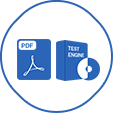Last Update 12 hours ago Total Questions : 162
The SnowPro Advanced: Architect Certification Exam content is now fully updated, with all current exam questions added 12 hours ago. Deciding to include ARA-C01 practice exam questions in your study plan goes far beyond basic test preparation.
You'll find that our ARA-C01 exam questions frequently feature detailed scenarios and practical problem-solving exercises that directly mirror industry challenges. Engaging with these ARA-C01 sample sets allows you to effectively manage your time and pace yourself, giving you the ability to finish any SnowPro Advanced: Architect Certification Exam practice test comfortably within the allotted time.
A company has a Snowflake account named ACCOUNTA in AWS us-east-1 region. The company stores its marketing data in a Snowflake database named MARKET_DB. One of the company’s business partners has an account named PARTNERB in Azure East US 2 region. For marketing purposes the company has agreed to share the database MARKET_DB with the partner account.
Which of the following steps MUST be performed for the account PARTNERB to consume data from the MARKET_DB database?
What built-in Snowflake features make use of the change tracking metadata for a table? (Choose two.)
A company needs to share its product catalog data with one of its partners. The product catalog data is stored in two database tables: product_category, and product_details. Both tables can be joined by the product_id column. Data access should be governed, and only the partner should have access to the records.
The partner is not a Snowflake customer. The partner uses Amazon S3 for cloud storage.
Which design will be the MOST cost-effective and secure, while using the required Snowflake features?
How can the Snowflake context functions be used to help determine whether a user is authorized to see data that has column-level security enforced? (Select TWO).
A healthcare company wants to share data with a medical institute. The institute is running a Standard edition of Snowflake; the healthcare company is running a Business Critical edition.
How can this data be shared?
The Data Engineering team at a large manufacturing company needs to engineer data coming from many sources to support a wide variety of use cases and data consumer requirements which include:
1) Finance and Vendor Management team members who require reporting and visualization
2) Data Science team members who require access to raw data for ML model development
3) Sales team members who require engineered and protected data for data monetization
What Snowflake data modeling approaches will meet these requirements? (Choose two.)
A company has an inbound share set up with eight tables and five secure views. The company plans to make the share part of its production data pipelines.
Which actions can the company take with the inbound share? (Choose two.)

